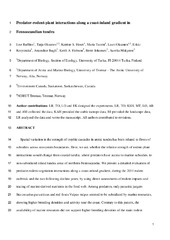Predator–rodent–plant interactions along a coast–inland gradient in Fennoscandian tundra
Permanent lenke
https://hdl.handle.net/10037/8649DOI
doi: 10.1111/ecog.01758Dato
2015-11-09Type
Journal articleTidsskriftartikkel
Peer reviewed
Forfatter
Oksanen, Lauri KalervoSammendrag
Spatial variation in the strength of trophic cascades in arctic tundra has been related to flows of subsidies across ecosystem boundaries. Here, we ask whether the input of marine subsidies in tundra systems would cause spatial variation in the strength of rodent–plant interactions between coastal areas, where predators have access to marine-derived resources, and non-subsidized inland areas of northern Fennoscandia. We present a detailed evaluation of predator–rodent–vegetation interactions along a coast-inland gradient, during the 2011 rodent outbreak and the two following decline years, by using direct assessments of rodent impacts and tracing of marine-derived nutrients in the food web. Our results revealed that the main rodent predator during summer, the long-tailed jaeger Stercorarius longicaudus, did not benefit from marine resources while breeding (relative dietary proportion in chicks’ diet = 0–3%). Contrary to this pattern, parasitic jaegers S. parasiticus, bred exclusively near the coast and preyed effectively on both marine resources (41% of chicks’ diet) and rodents (12%). Mammalian predators also showed a higher activity during winter near the coast. Despite overall higher predator numbers, no evidence was found for lower rodent population growth rates during the three monitoring summers and for weaker rodent grazing impacts in the coastal area. Instead, we documented pronounced damages caused by lemmings and voles on bryophytes and vascular plants, especially dwarf shrubs (e.g. Vaccinum myrtillus) all along the coast–inland gradient. Taken together, our results did not support the hypothesis that marine subsidies would trigger a trophic cascade in coastal tundra areas of northern Fennoscandia during a major rodent outbreak, probably due to a relatively low diversity of marine-subsidized predators in the region. Comparative observational and experimental studies at large spatial scales in various arctic regions are absolutely necessary for a better understanding of factors causing regional variations in the functioning of arctic food webs.
Beskrivelse
Accepted manuscript version. Published version at http://doi.org/10.1111/ecog.01758.


 English
English norsk
norsk